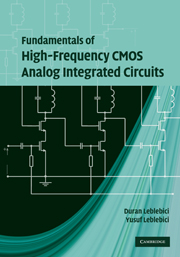Book contents
- Frontmatter
- Contents
- Preface
- 1 Components of analog CMOS ICs
- 2 Basic MOS amplifiers: DC and low-frequency behavior
- 3 High-frequency behavior of basic amplifiers
- 4 Frequency-selective RF circuits
- 5 L-C oscillators
- 6 Analog–digital interface and system-level design considerations
- Appendix A Mobility degradation due to the transversal field
- Appendix B Characteristic curves and parameters of AMS 0.35 micron NMOS and PMOS transistors
- Appendix C BSIM3-v3 parameters of AMS 0.35 micron NMOS and PMOS transistors
- Appendix D Current sources and current mirrors
- References
- Index
1 - Components of analog CMOS ICs
Published online by Cambridge University Press: 05 June 2012
- Frontmatter
- Contents
- Preface
- 1 Components of analog CMOS ICs
- 2 Basic MOS amplifiers: DC and low-frequency behavior
- 3 High-frequency behavior of basic amplifiers
- 4 Frequency-selective RF circuits
- 5 L-C oscillators
- 6 Analog–digital interface and system-level design considerations
- Appendix A Mobility degradation due to the transversal field
- Appendix B Characteristic curves and parameters of AMS 0.35 micron NMOS and PMOS transistors
- Appendix C BSIM3-v3 parameters of AMS 0.35 micron NMOS and PMOS transistors
- Appendix D Current sources and current mirrors
- References
- Index
Summary
MOS transistors
The basic structure of an n-channel metal–oxide–semiconductor (NMOS) transistor built on a p-type substrate is shown in Fig. 1.1. The MOS transistor consists of two disjoint p-n junctions (source and drain), bridged by a MOS capacitor composed of the thin gate oxide and the poly-silicon gate electrode. If a positive voltage with sufficiently large magnitude is applied to the gate electrode, the resulting vertical electric field between the substrate and the gate attracts the negatively charged electrons to the surface. Once the electron concentration on the surface exceeds the majority hole concentration of the p-type substrate, the surface (the channel) is said to be inverted, i.e., a conducting channel is formed between the source and the drain. The carriers, i.e., the electrons in an NMOS transistor, enter the channel region underneath the gate through the source contact, leave the channel region through the drain contact, and their movement in the channel region is subject to the control of the gate voltage.
To ensure that both p-n junctions are continuously reverse biased, the substrate potential is kept lower than the source and drain terminal potentials. Note that the device structure is symmetrical with respect to the drain and source regions; the different roles of these two regions are defined only in conjunction with the applied terminal voltages and the direction of the drain current.
- Type
- Chapter
- Information
- Publisher: Cambridge University PressPrint publication year: 2009



